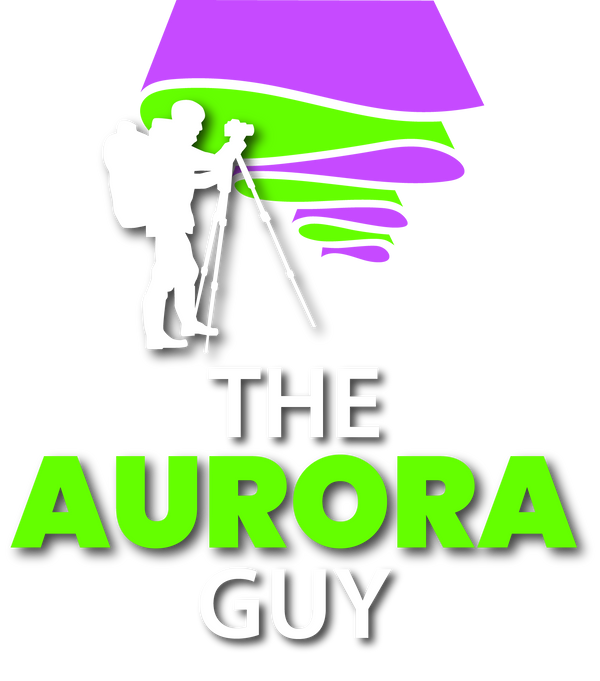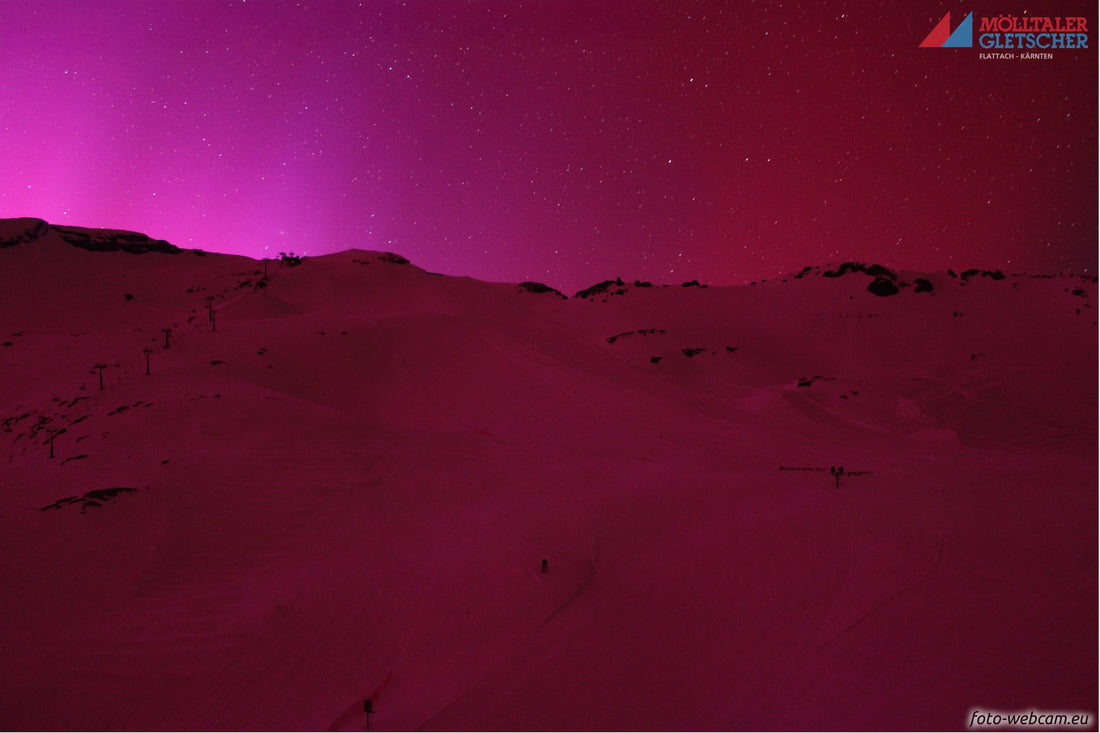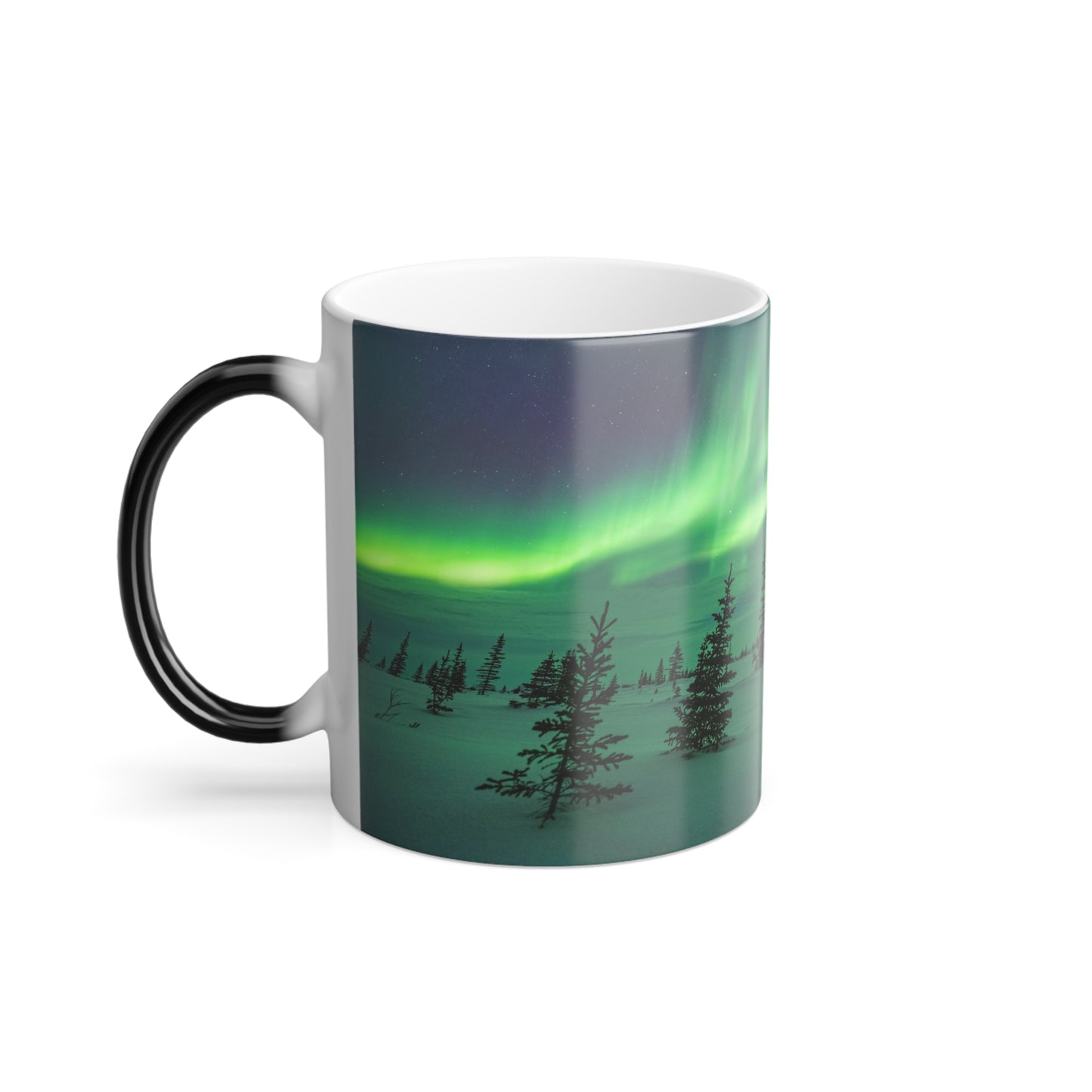Introduction
2024 was a banner year for aurora chasers. May 2024 saw the largest geomagnetic storm since 2003 and with it an extreme show of the aurora around the world. In fact, I was able to capture the northern lights on a vacation in India, which was definitely not something I was planning on! Many studies have now been published or submitted for publication that characterize the geomagnetic storm and its effects. Two publications that I was co-author on highlight the extreme auroral observations made during the event.

Hayakawa et al. (2024; accepted) shows reported auroral visibility from 10 May 2024 to 12 May 2024. The contour lines indicate the magnetic latitude with an interval of each 10°. The solid line indicates the magnetic equator. The red and blue dots indicate auroral reports with naked-eye vs. on-camera visibility, respectively. Visibility reports from Grandin and ARCTICS Collaboration (2024) and Wicklund (2024) as greenish and grey small dots, respectively.

This figure from Grandin et al. (2024) shows reported colors of the aurora (a) in pictures and (b) visible to the naked eye during the 10 May 2024 geomagnetic storm, as a function of geomagnetic latitude. Data from both hemispheres are blended together.
Aurora chasers made huge contributions to the field by collaborating with scientists to study how the Earth responded to all this activity. One unique study highlights citizen science all-sky camera data from backyard observatories in Missouri. Scientists utilized these high-resolution (in time and space) color images to infer the energy and composition of particles raining down in our atmosphere based on the ratios of blue to red to green colors. This model was then used to calculate the amount of electric charge in the atmosphere (total electron content) that affected GPS communications around the United States. In fact, GPS outages felt by the farming industry are estimated to have caused more than $500 million in lost profits from delays in planting. Other industries were affected as well. Oil drilling operations halted due to issues with precision drill bits losing their positioning. In space, over 6,000 Starlink satellites autonomously raised their altitude due to the atmosphere expanding (this happens during geomagnetic storms and causes increased drag on low-flying satellites; e.g., Berger et al. 2023), creating a headache for space traffic management and potential cases of de-orbiting. Many satellites were also put in safe modes due to higher radiation dosages, and some small cube-satellites (cubesats) had their lifespans shortened significantly. Transpower, New Zealand’s power grid service, experienced significant voltage issues and had to shut off power to the North and South islands for two days. So, yes, the May event, while not catastrophic like a Carrington event may be, created real impacts and costs on society.
Aurora photographed from Namibia during the Gannon Storm
But while the Gannon Storm has received a great amount of attention from the scientific community, the October 10-11 event, while not as strong in many ways, seemed to create more impressive auroral displays for auroral chasers. Right after the October storms, I asked my followers on X whether the Gannon Storm or the October 10 storm was more impressive, and October beat May 51% to 49%. And while on paper, the October event may appear as just a notable space weather event, scientifically, it is VERY interesting. The event is also a rare time when solar observations, forecast models, and ground-truth auroral visibility all seemed to align. How and why did this happen? Finally, while auroras weren’t seen to such low latitudes as during the Gannon Storm, they were still widespread. If you photographed or witnessed the aurora with your own eyes, consider completing this survey which will help scientists map the aurora from this event. Also, submit your observations to Aurorasaurus. You may also attach photos you took in the form, and one way to get an accurate time and location of your observation is to use smartphone images – your phone automatically records exactly when and where you saw the aurora.
So, let’s unpack the October storm from start to finish and explain what happened! For many aurora chasers, this event created the best auroras they had ever seen, but why? Read on!
What caused the October 2024 storm?
The most powerful geomagnetic storms and thus most widespread sightings of aurora are caused by coronal mass ejections (CMEs) launching out of the Sun and hitting our planet. On October 9, 2024 at 1:56 UTC, an X1.8 flare occurred from Active Region (AR) 3848.
When AR 3848 released this severe X-class flare, the released energy destabilized a portion of the Sun’s atmosphere and caused it to launch away in what is called a coronal mass ejection, or CME. CMEs are sometimes referred to as “blasts,” or “Sun sneezes,” but they are simply large ejections of charged particles out into space, emerging like a cannon firing a cannonball. Occasionally, these CMEs can be directed at Earth, and the energy from them can penetrate through our magnetic shield and eventually into the aurora. The actual interactions are more complex than that, and if you want to learn more, I recommend consulting this blog post on the HUXt forecast which contains good contextual information on CMEs.
The CME released during the X-flare on October 9 was relatively wide and fast and, most importantly, was heading straight towards Earth. We could tell this by analyzing instruments called coronagraphs. Coronagraphs are designed to image the wispy solar wind flowing out from the Sun’s atmosphere. A camera takes an image of the Sun with a small metal disk placed over the Sun’s center. This creates an artificial eclipse and blocks the harsh light, allowing a longer exposure to be used on the camera to image faint puffs, or ejections, of solar wind extending outwards in the form of CMEs. For coronagraphs located near Earth, like the LASCO C2 and C3 instruments onboard SOHO, a CME heading directly at Earth (or directly away from Earth) appears as a halo of material expanding around the Sun. These “halo CMEs” are what we look for when forecasting if a CME will arrive at Earth. On October 9, we saw a solar flare, a shockwave of plasma ripple through the Sun’s atmosphere as a CME launched, and the telltale halo CME expansion in coronagraph imagery. Something was coming!

Clear Halo CME seen in difference-imagery from LASCO C2 onboard SOHO. The blue and red contours mark the boundaries of the CME found by computer algorithms.
A near-perfect prediction
It’s important to model CMEs to estimate their strength and arrival time if they are directed our way. The most severe space weather events take place due to CME effects, and while we don’t yet have a good way of modeling the magnetic orientation of a CME (e.g., Bz) ahead of time, an arrival time and speed of a CME can tell a lot about its potential forcausing a geomagnetic storm at Earth when it comes. When the large halo CME was seen on October 9, space weather forecasters sprung into action and released their predictions of when the CME would arrive at Earth. A few different model screenshots are seen below, including the HUXt model and NOAA SWPC’s WSA-ENLIL graphic. While there were some disagreements between groups and their forecasts, one thing was clear - something was bound to hit Earth on October 10 or 11, and it was going to be strong!
 HUXt model.
HUXt model.

The strong CME prompted NOAA SWPC to release a RARE G4 severe geomagnetic storm watch for October 10-11, only the second time the agency had released such a watch since 2003.

Aurora chasers around the world geared up for what was expected to be a major event. These types of CMEs are exciting - rarely do we see such a fast and well-defined full halo in coronagraphs. Most CMEs are off to the side launching away from Earth, weak, and hard to model with large arrival time margin of error. Even full halo CMEs can somehow miss Earth, and all models are inaccurate to some degree, but even to seasoned space weather enthusiasts, the October 10 event was hype-worthy.
Impact
At approximately 14:48 UTC on October 10, a shockwave of solar wind passed by solar wind monitors at L1 (Lagrange Point 1), 1.5 million kilometers from Earth. Spacecraft located at L1 are like buoys in the solar wind, providing a short-range (30-60 min depending on the solar wind speed) forecast of what’s coming at us. Solar wind monitors like ACE and DSCOVR saw a sharp increase in magnetic field strength (Bt), density, and speed, indicative of the shock front of a powerful CME. Bt rose from around 10 nT to over 30 nT in the matter of 10 minutes, density rose to 40 particles/cc, and speed jumped from 400 km/s to over 800 km/s. But, how strong is that? Well, “quiet” solar wind is typically around 5 nT in Bt, 5-10 particles/cc, and 300-400 km/s in speed. A strong CME is typically one with a field strength over 20 nT and speed above 500-600 km/s. So, the October 10 CME compared to these typical values was a very strong event.
 Solar wind data for October 10-11, 2024
Solar wind data for October 10-11, 2024
Auroral Response
As expected from such a strong impact, the effects on the aurora from the October 10 CME were quite profound. Immediately, auroras exploded over high-latitude regions and the compression of Earth’s magnetosphere caused many low-energy particles to become excited and precipitate into the atmosphere. These low-energy particles manifested as bright, red auroras, and as Europe fell into darkness around 17 UT on October 10, many aurora chasers at mid-latitudes saw their skies turn crimson with the light of tall, red auroral rays stretching into the sky. These initial bright auroras are common (e.g., Brittnacher et al. 2000, Liou et al. 2007, Laundal, Ostgaard 2008, Henderson et al. 2006) immediately following the impact of a strong CME on our magnetosphere, ringing it like a bell. During exceptional geomagnetic storms, including the March 1989 extreme geomagnetic storm and (potentially) the Gannon storm, Great Red Auroras may occur, an extremely-bright form of red auroras that are actually different than normal red auroras we see during substorms and in general during during big events (Kozyra et al. 1997). So far, it isn’t clear if the October 10 event created any Great Red Auroras, but filling in more observations with photos and accurate geolocation and timing information is important for confirming this idea.

Webcams across Europe turned red with aurora soon after the CME impacted Earth.
Soon after the CME hit Earth and was felt by our magnetosphere, NOAA SWPC issued a G4 (Kp 8; Severe) geomagnetic storm alert.

Even after the impact of a strong CME, there is no guarantee auroras and geomagnetic activity will last. Some CMEs peter out quickly even if they look strong in the beginning. So, while initially there was some question of whether North America would see the same caliber of aurora Europe did, once the core of the CME brushed past L1 satellites with a strong Bz south component, it was clear the October 10 storm would not be letting up anytime soon.
In North America, intense pink and red auroras were seen as soon as skies were dark in Maine and other east coast states. For a comprehensive list of aurora webcams around the world, visit the dedicated page on my website.

At around 2:30 UT on October 11, auroras were even photographed on a mobile phone dancing on the northern horizon from Haiti:
 Interestingly, while auroras were seen very far equatorward, the OVATION Prime model still showed the auroral oval only extending to areas like Pennsylvania, New York, or Ohio.
Interestingly, while auroras were seen very far equatorward, the OVATION Prime model still showed the auroral oval only extending to areas like Pennsylvania, New York, or Ohio.

In fact, this was one major point of confusion amongst aurora chasers, especially those using mobile applications relying on probability of seeing aurora derived from the OVATION model. While all models have their shortcomings, the OVATION Prime model is notorious for underestimating auroral visibility during periods of intense activity, including during geomagnetic storms and substorms (Mooney et al. 2021).
OVATION Prime is an empirical model (Newell et al. 2014), meaning it is built on real data. In this case, solar wind data and data describing the strength of auroral emissions. With enough of these observations, one could say, “If we see solar wind data with certain Bt, Bz, and speed, we should expect a certain amount of aurora to be produced.” This works for statistical averages, but the magnetosphere and aurora are a dynamic system controlled by many factors other than solar wind.
Since OVATION also does not look at patterns of solar wind and only compares instantaneous values and general trends, there is no way to predict substorms which often occur when Bz flips from south to north, and other complex solar wind-magnetosphere interactions that can cause various types of auroras to occur.
Since data during geomagnetic storms are inherently more sparse (there are more days without storms than storms), OVATION also cannot handle large events like the May and October geomagnetic storms, because, simply put, it has never been trained on such extreme data. All this means that during the October 10 storm, your aurora app likely would have failed at predicting when the lights would have been visible and would have underestimated your chances of seeing the aurora. As has been said countless times before, webcams, magnetometers, and reports from other aurora chasers are the best tools for accurately predicting where and when the aurora can be seen in real-time.
Around the same time as the OVATION Prime screenshot attached above, naked-eye auroras were seen as far south as Texas.
 As night continued for North American chasers, widespread auroral displays continued, marked by intense, vibrant bursts of red aurora. Around midnight on October 11 UTC, the Hp 30 index reached a value of 10.5 which comes close to the maximum value of 11 of the Hp 30 index during the Gannon Storm.
As night continued for North American chasers, widespread auroral displays continued, marked by intense, vibrant bursts of red aurora. Around midnight on October 11 UTC, the Hp 30 index reached a value of 10.5 which comes close to the maximum value of 11 of the Hp 30 index during the Gannon Storm.

While I (with the help of Tanya Melnik) analyze Canadian magnetometer stackplots in a later section of this blog, the auroral electrojet (AE) index readings were off the charts. These readings indicate intense currents in the auroral zone corresponding to stronger visible aurora. Typically, values over 500 nT indicate a decent substorm is underway. My benchmark for naked-eye mid-latitude viewability in the United States is 1000 nT. Large spikes in the AE can be correlated with substorm activity except shortly after CME impact. The initial shock of the CME created a strong reading >~3000 nT around 2024-10-10 15:45 UTC. Subsequent spikes in the AE index were likely due to substorms over the European sector. Starting on October 11th, large spikes in the AE index were seen with substorms. At one point, the AE reached a value over 2000 nT, likely close to 3000 nT, due to effects from a violent auroral substorm around 8 UTC.

A plot of the AE index for October 10 and 11 from the World Data Center for Geomagnetism, Kyoto.
For space weather forecasters at the NASA Moon to Mars (M2M) office, visible auroras in the Washington D.C. area were not only captivating but validating. A well-timed forecast had played out perfectly from start to finish:

Overhead displays of green and red were seen in states such as Minnesota, North Dakota, Wisconsin, Michigan, Iowa, Illinois, Maine, Montana, Washington, Oregon, Idaho, South Dakota, New York, Vermont, and others. During substorms, intense red auroras and tall pillars created horizon shows for U.S.-Mexico border states. Even some rare auroral phenomena were observed, including SAR (Stable Auroral Red) arcs which graced the skies overhead southern U.S. states like Oklahoma, Texas, and Arizona.

 This photo by Jim Tang shows a SAR arc (left), the milky way (middle), and the aurora (right).
This photo by Jim Tang shows a SAR arc (left), the milky way (middle), and the aurora (right).
High-latitudes were relatively quiet during substorm growth phases when the auroral oval became narrow and extended equatorward, but still enjoyed active, intense overhead auroral displays during poleward movements of aurora during expansion phases. After living up in Alaska for two years, I can say that "Yes, the aurora can be too far south at times,” but during intense activity, auroral forms and colors are often sporadic, wild, and unpredictable. High-latitudes still win even if you saw the October 10 and/or May 10 displays from mid-latitudes ;).
Analyzing data from Chris Wicklund and others, who captured reports of the aurora via X, formerly Twitter, I created an animated map of auroral reports over time for the October 10-11 geomagnetic storm:
As you can likely see, large clusters of reports appear at once over the United States, and delving into the data, you can see many of these reports come at specific times around 2:00, 4:00, and 7:00 UTC on October 11. These three times are when large auroral substorms briefly pushed viewability of the aurora to lower latitudes.
Downloading data from the Suomi National Polar-orbiting Partnership (SNPP) Visible Infrared Imaging Radiometer Suite (VIIRS) Day-Night Band (DNB) instrument, I stitched together a mosaic of satellite images showing the extent of the auroral oval during the storm in the figure below. VIIRS DMB takes pictures in the 500-900 nm range and is meant to detect light pollution, but the aurora often shows up when the satellite flies over polar regions.

An animation built from data hosted by the KNMI Space Weather Timeline Viewer shows these images with a color intensity scale:
As CME effects waned throughout October 11th and 12th, so did the geomagnetic storm, and the 6th strongest geomagnetic storm of the last three cycles (as of writing, and by typical benchmark of the Dst) was recorded.
The curious case of auroral substorms
What are auroral substorms?
Auroral substorms are fundamental daily space weather phenomena that are extremely important to understand if you are an aurora chaser (watch a breakdown of the seminal Akasofu 1964 paper on substorms here). There are typically three stages of auroral substorms - growth, expansion, and recovery. From the high-latitude perspective, during the substorm growth phase, auroral energy charges up as quiet auroral arcs move from the poleward to equatorward sky. These migrating auroral arcs are indicative of a magnetospheric phenomenon known as “tail stretching” or “tail loading.” During this time, particles funneling into the magnetosphere (e.g., from south Bz solar wind and Dungey cycle convection) are held in the magnetotail as it stretches out and becomes tense. This is similar to a slingshot pulling back a projectile of buckshot (aurora particles). The exact physical process that controls the motion of these arcs and the corresponding magnetospheric processes are under debate in the scientific community and require an entire blog post to explain. In the GOES magnetometers (GOES Mag), the substorm growth phase appears as a reduction in the Bz component of the magnetic field - as the rubber band magnetic field stretches out, it grows thinner, reducing its z-component (height).
As the growth phase continues, the magnetosphere becomes more and more unstable. Imagine trying to pull back a slingshot more and more - eventually your hands start shaking as the tension increases - something must give eventually! When the slingshot fires its buckshot of aurora particles back at Earth, that is when substorm expansion takes place. In a matter of minutes, quiet auroral arcs can grow intense beaded structures (auroral beads) and rapidly move poleward (poleward expansion).
Animation of Dungey cycle convection leading to magnetic reconnection and a substorm.
Massive amounts of charged particles are dumped into the atmosphere, and at all different kinds of energies (broadband). Notably, auroral arcs are largely monoenergetic, meaning that the precipitating electrons (particles causing aurora falling into our atmosphere along magnetic field lines) all have about the same level of energy and therefore penetrate the same distance into our atmosphere. This creates the canonical green auroral arc with red tops.
 A “classic” auroral arc built from red and green emissions. Photo taken from the ISS.
A “classic” auroral arc built from red and green emissions. Photo taken from the ISS.
However, during substorms, particles of all energies create aurora, which is why during these expansion phases we see more intense reds and also the rare nitrogen fringe of pink/purple emission below the usual green light. During these substorm expansion phases, then, auroral arcs and curtains grow very tall with high-altitude red emission from low-energy particles that simply don’t penetrate very far into our atmosphere. These tall auroral curtains can be seen further away than the aurora during the growth phase. They are also brighter due to the increased amount of energy flowing into the aurora (Newell et al. 2009).

An auroral arc almost entirely produced from low-energy electrons given the strong red and pink colors without green emission. Image taken in Fairbanks, Alaska in December 2023.
Chasing the aurora at high-latitudes, these auroral substorm expansions create the fast-moving “dancing” displays that are coveted by aurora chasers, with huge auroral spirals and bright ribbons racing across the sky. From far enough away, however, these expansion phases may just appear as a red glow suddenly appearing on the horizon with some side-to-side movement of tall auroral rays or pillars for a few minutes.

Red auroral glow seen from Germany on October 11, 2024. Photographed by Andreas Kretschmer.
This is when the aurora “flares up.” In GOES magnetometer measurements, expansion phases look like large spikes in the readings as field lines turn from stretched to a more rounded/dipolar shape.
Substorm expansion phases usually last around 15-30 minutes and are followed by a period of recharging called the recovery phase. During this time, a different kind of auroral form is seen dominating the sky - pulsating aurora. Patches of pale green/pink emission slowly move equatorward, even further equatorward than the growth phase aurora before expansion. Directly underneath these patches, the aurora appears to flicker on and off with a frequency of about 3-10 seconds. From the side, these patches appear to flicker like flames with waves of emission starting from the base moving upwards. These pulsating patches can remain even during the growth phase of another substorm. During large geomagnetic storms, the equatorward extension of the pulsating aurora can be very pronounced, filling the skies over mid-latitudes. The substorm recovery phase varies in length, but can be as short as an hour. Under quiet conditions, it is typical to experience one substorm per night around 11 pm-2am. During geomagnetic storms, it is common to experience multiple substorms per night as the magnetotail quickly refills with particles after a large injection of energy. Check out this incredible video of pulsating aurora in real-time captured by Chris Ratzlaff after a large substorm on November 4, 2021:
Arguably the most photogenic and visually-appealing auroral displays occur during substorm expansions, so if you can time these just right, you can enjoy the best of the show. Not all substorms are created equal - some are more intense than others or contain different particle populations that can accentuate certain colors, like reds and purples. Particularly strong substorms can force a great number of particles into the atmosphere (including higher fluxes of less common low-energy particles), creating strong high-altitude auroral emissions. During the Gannon Storm, scientists estimated auroral rays stretched almost 900 km in the sky during a strong substorm. These emissions could have been visible hundreds of km equatorward of the base of these pillars. This is why experienced chasers say not all geomagnetic storms of the same Kp strength are “created equal” - a Kp 5 geomagnetic storm comprised of a series of small, unimpressive substorms may drive more sustained showings of aurora but confined to high latitudes whereas another Kp 5 storm comprised of a couple intense substorms may drive auroral sightings down to Mexico-border U.S. states.
When we look back on geomagnetic storms in the context of auroral visibility, we need to examine substorms - how powerful were they and how did they affect auroral visibility?
Substorms during the October 10-11 event:
During the October 10 event, especially during the nighttime hours over North America on the night of October 10 into October 11, many aurora chasers remarked at the intensity of what seemed like evenly-timed auroral substorms. Because the October 10-11 event was the largest geomagnetic storm since the Gannon Storm, I asked my followers which storm they preferred… the responses were interesting, but a couple comments stood out:
“From a perspective here in Ohio, I vote October but they both were very different. The May event felt more prolonged with more colors, and it also seemed further south. October had such intense substorms that were beyond anything I’ve ever laid eyes on. May on the left, Oct right” - @MikeParry86
“My experience (New Brunswick) was that last night was more colourful without question but had short lived substorms. May had more active movement and seemed to be more persistent. With the exception of one brief moment last night, I found May was more exciting to watch overall.” - @BradJPerry
Looking back on the data, these intense substorms are apparent in GOES Magnetometer readings from October 11 (UTC time). The scaling on the graph had been automatically adjusted to show the excursions of the GOES satellites into the magnetosheath on October 10 (during intense geomagnetic activity, the magnetopause comes close to Earth (e.g., Samsonov et al. 2021) inside geostationary orbit where the GOES satellites are located, exposing the instruments to intense magnetic fields during the daytime hours for North America). So, courtesy of Jim Tang, I have included a plot without these excursions to see changes better.
You can clearly see three (possibly four) substorms seemingly evenly-spaced with a frequency of around three hours. In a post by Hunter Hurley on X, you the effects of these substorms on the aurora are obvious with large bursts of bright red pillars on the horizon as dipolarizations occur (What is a dipolarization? Read my blog article on GOES Mag here).


These substorms were extremely potent, with GOES measurements in the single-digits before dipolarizations. These low values indicate a high amount of magnetotail stretching (analogous slingshot pulled very far back). When the dipolarizations occurred, they were very large, with huge increases of 40-50 nT in a matter of minutes. These sharp increases indicate a fast surge of auroral particles being released from the magnetosphere all at once, making the aurora flare up suddenly and violently.
The YouTube video below shows these three distinct substorms in three different cameras set up on the night of the storm in Missouri. In each camera (north, northeast, and south), the substorms can be hard to see since the aurora envelops the entire field of view. The all-sky camera shows the substorms better. I recommend watching at 2x speed.
Analyzing the auroral imagery, the first and largest substorm begins at around 2024-10-10 20:51 CDT (2024-10-11 1:51 UTC; 1:15:44 video timestamp). The second substorm begins at around 2024-10-10 23:15 CDT (2024-10-11 4:15 UTC; 1:21:28 video timestamp). The third substorm begins around 2024-10-11 2:24 AM CDT (2024-10-11 7:24 UTC; 1:28:59 video timestamp).
Comparing these times of auroral intensification to the GOES Magnetometer readings, we can see they agree very well. The first substorm in GOES occurred around 1:45 UT for GOES East and around 1:55 UT for GOES West. The second substorm occurred around 4:15-4:20 UT in GOES Mag, however, the rise in the readings (how “spikey” did it look) was more gradual than the first substorm. The two satellites were also more asymmetric in their dipolarization with GOES East rising much higher than GOES West. The third substorm appearedaround 7:15 UTC in GOES West and around 7:30 UTC in GOES East. GOES East showed a stronger dipolarization than GOES West.
The slower rise of GOES Mag in the second and third substorms may correlate with the slower and weaker intensification seen in the aurora from Missouri. While the first substorm created very bright, red pillars that extended and moved overhead, the second and third substorms were comparatively fainter.
The fact that some substorms in GOES Mag do not line up with the intensification of the aurora seen in the timelapse from Missouri may be due to multiple factors.
Why does GOES mag sometimes not line up, exactly?
Prepare to nerd out! But if you’re a fan of GOES Mag, this will be interesting to you! First, since the GOES satellites are in geostationary orbit (at 6.6 Earth radii), their position in the magnetotail changes throughout the night. GOES East is positioned over the U.S. east coast while GOES West is positioned over the U.S. west coast. Every day, both GOES satellites, while fixed above the same points on Earth, sample the magnetosphere from dayside to nightside. On a quiet night, you will see the curves of both satellites oscillate slightly out of phase since GOES East samples the magnetotail before GOES West. Splitting the U.S. in half, say in the central time zone, around midnight, both satellites are in the magnetotail and both east and west satellites respond in unison to a dipolarization in Earth’s magnetosphere. However, in their extreme dusk or dawn sectors, the satellites may not be able to detect the main flow of particles responsible for the substorm, only sides of it. Using the rubber band analogy, it would be like firing the buckshot projectile to the side of your target (in this case, one of the GOES satellites) - a few pieces may hit it, but most of the ejecta will miss. If you are using the GOES satellites to time substorms early in the night (e.g., 8 pm ET), they may not “see” the substorm until it has intensified. In the magnetosphere, the channel of incoming auroral particles likely widens as the substorm progresses, encompassing a wider longitude.
Second, when substorms initiate somewhere in the auroral oval, depending on their strength, they can spread out some distance in longitude (Liou et al. 2002). A very powerful substorm could affect the entire nightside auroral oval. If both GOES satellites are positioned in the magnetotail (around midnight central time, let’s say), and a powerful substorm occurs, while aurora chasers around that magnetic local time will see the aurora brighten at the time GOES readings spike, aurora chasers to the extreme east (dawn) and west (dusk) sides of the auroral oval may have to wait. The actual onset of an auroral substorm usually happens in a relatively thin section of longitude (300 miles/480 km wide, maybe), then auroral forms spread out in either direction to the east and west, sometimes appearing as spirals/cinnamon rolls on the horizon if you are far away from onset (Partamies et al. 2001).
Eventually, the auroral substorm falls apart. An analogy to this would be like dropping a rock in a body of water. The initial splash is the auroral substorm beginning, then the fading ripples traveling out is the substorm expansion propagating across the auroral oval. There is no set speed at which the aurora propagates, but one time I watched a substorm onset over Yellowknife, monitoring conditions using a live all-sky camera feed, then saw a surge of aurora appear on the eastern horizon in Fairbanks around 15 minutes later, moving overhead and to the west as an auroral spiral. GOES West had shown the spike right as the substorm began over Yellowknife, but the substorm took time to “get to me” in Fairbanks. Since Fairbanks and Yellowknife are separated by a distance of around 1000 miles (1600 km), the substorm “traveled” at 4000 mph (about 6400km/h). Not all substorms can “travel” this far and are instead more localized perturbations of the auroral oval, and sometimes large sections of the auroral oval can intensify at once during an onset. The point of explaining all of this is so you understand the limitations of GOES Mag and how substorms work.
In this video, you can see an auroral substorm propagating throughout the auroral oval:
These nuances to auroral substorms will be expanded upon in future blogs, so stay tuned!
Analyzing the 2024 October event through ground magnetometer data (written by Tanya Melnik)
GOES magnetometers can tell us a lot about the condition of the magnetotail, or how far the slingshot has been pulled, and when it was released. Ground magnetometers can tell what aurora is doing, or where and when that buckshot lands. Many aurora chasers may not be as familiar with the ground magnetometers, so let’s cover some basics first.
Magnetometers are devices that measure both strength and direction of Earth’s magnetic field at a specific location. There are hundreds of these devices positioned around the world forming a magnetometer network used to monitor and study our magnetic field. Several magnetometers aligned in north-south distribution form a magnetometer line. Magnetometers respond to strong currents flowing in the atmosphere, much closer to the surface than GOES magnetometers and a lot closer to where aurora is formed. There are some variations in magnetometer readings even on a quiet day, however, things really pick up when the magnetosphere interacts with strong solar wind. As the magnetotail gets loaded with the energy from the solar wind and starts to release that energy as a substorm, currents in the lower atmosphere become stronger with the flow of particles. Think of it as a release of a slingshot with the buckshut landing in a lake. The initial impact will generate a wave that will be going in all directions, but the tallest wave will be at the site of the impact.
As auroral currents intensify, they change both strength and the direction of the magnetic field. This change can be seen in the horizontal orientation, measured by the H-component.
An isolated substorm has a distinct appearance in the magnetometer plot. It will have a small rise in the H-component in the growth phase and a big drop in the expansion phase followed by gradual return to baseline in the recovery phase. A single magnetometer tracing for the substorm will look like this:

This is a plot of the magnetometer located at Gillam, Manitoba, Canadian magnetometer array CARISMA. The growth phase is small and can be seen just before 5 UTC (pink). It is followed by a deep drop (green) with gradual recovery (blue). A single magnetometer can be used to tell that the aurora is building up if the growth phase is clear. But more importantly, it can tell that aurora is starting to fire up as the line tracing starts to drop. The initial part of the drop is where aurora colors are the most vivid which makes aurora chasing all about catching the early expansion phase for the best shot.
A line of magnetometers can tell a lot more about aurora location. Magnetometer tracings plotted from north to south are called magnetometer “stackplots.” Tromso Geophysical Observatory (TGO) is a useful site for magnetosphere monitoring. It has several preset stackplots for different locations, including Alaska and Canada. A custom stackplot can also be made, such as the Churchill line of magnetometers lined up in nearly a straight line in the middle of Canada. The magnetometers selected for the custom stackplot are Rankin Inlet (RAK), Fort Churchill (FCU), Gillam (GIL), Island Lake (ISL), Little Grand Rapids (LGR), and Pinawa (PIN).

Just as the buckshot will make the tallest wave at the site of the impact, substorm auroral currents will create the deepest drop in the H-component of the nearest magnetometer. This will be the location of the overhead aurora. As can be seen from the substorm tracing, Gillam (GIL) was the site closest to the current and likely had activity overhead for that substorm.
Timing of the drop looks different in different magnetometers, corresponding to the time it takes for the current to reach that location from the substorm onset. The station with the earliest drop will be the one that saw the substorm first. That confirms Gillam (GIL) as the first station to be reached by aurora.
Things get a lot more complicated during geomagnetic storms. The Gannon Storm had several overlapping substorms, a common pattern of our magnetosphere’s response to strong solar wind driving.
 Tracing for May 11th in the CARISMA array of magnetometers.
Tracing for May 11th in the CARISMA array of magnetometers.
As can be seen from the stackplot, telling the growth phase of every substorm becomes impossible. A few strong periods of activity can still be picked up for the deep drops. Despite the drops looking similar in magnitude to the isolated substorm, the scale in the upper right corner of the stackplot of the magnetic field indicates that the measurements are very different. This indicates that the magnetometers were seeing very strong changes in the magnetic field.
Let’s look at the October 10-11 storm in the array of magnetometers:

The scale of the magnetic field measurements is indicative of significant changes in the magnetic field detected by the magnetometers. Overall, the pattern of strong substorms looks very similar to GOES Mag: strong substorms (blue shading) about every 3 hours. There were no recovery phases for those substorms as the tracing showed ongoing disturbance between the strong substorms. This ongoing disturbance is reflective of strong ongoing convection (a la Dungey cycle) and steady energy transfer from the magnetosphere to lower parts of the atmosphere. It occurs during any storms, however, can be particularly appreciated during sawtooth events.
Thank you to Tanya Melnik for writing this section for me.
The October 10-11 Geomagnetic Storm contains a "Sawtooth Event"
If you glance at the GOES Mag timeline for the October 10-11 event, you’ll see that during the North American night (roughly 0-12 UTC), the plot looks almost like a saw with three teeth/blades. In this case, each tooth represents an individual substorm. Thus, we call these nightly patterns of subsequent magnetotail stretching and dipolarization “sawtooth events” (STEs; Fung et al. 2016, Partamies et al. 2009). STEs are relatively uncommon, and they are almost entirely unknown to the aurora chasing community. Thus, learning more about these events requires a literature search and deep dive into scientific papers. While STEs on paper just look like a series of substorms in quick succession, many scientists think they represent a fundamentally different mode of Earth’s magnetosphere (Borovsky 2004, Henderson 2004). STEs have been regarded as stormtime (occuring during geomagnetic storms) phenomena, occurring when the Bz is below -10 nT for an extended amount of time. However, STEs with such intense solar wind magnetic field strengths as those seen during the October event have never been observed.
Looking at the solar wind parameters at L1 for the October 10-11 geomagnetic storm, we see a period of over 11 hours of entirely southward Bz starting around 2024-10-10 22:00 UTC and lasting until around 2024-10-11 09:30 UTC. The sawtooth event occurred during the middle of this time period.
 Solar wind driving during the October 10-11 geomagnetic storm.
Solar wind driving during the October 10-11 geomagnetic storm.
Steady magnetospheric convection (SMC; Sergeev et al. 1996) occurs when the solar wind driving (e.g., low to moderate negative Bz) dumps consistent energy into the magnetosphere and into the aurora, but no substorm is observed. If you remember your Dungey Cycle (if you aren’t familiar with the Dungey Cycle, check out the seminal paper or this classic video), SMC occurs when magnetic reconnection rates on the dayside of Earth’s magnetosphere equal the reconnection rates on the nightside in the tail. Typically, when we are in a substorm growth phase, the reconnection rate at the dayside is much higher than the nightside. This leads to a build up of magnetic pressure in the tail and subsequent thinning of the current sheet (stretching rubber band). In SMC, the two reconnection processes balance out, and energy from the solar wind can efficiently stream into the magnetosphere and down into the aurora without any pressure imbalance forcing a substorm to start growing. Typically, the auroral signature of SMC is a bright, fat auroral arc in the northern horizon at mid-latitudes, or many hours of discrete auroral arcs stretching across the sky if you were located under the auroral oval. SMC aurora is relatively bright compared to quiet growth-phase arcs which can actually become dimmer before substorm onset and expansion. However, the lack of movement is a bit boring, so many aurora chasers do not like this type of aurora and magnetospheric state.

SMC aurora photographed by Marybeth Kiczenski from Michigan. Check out her Facebook page and website! Note the featureless, albeit bright arc on the northern horizon.
STEs occur with sustained, relatively steady moderate to strong negative Bz beyond the point where balanced reconnections can be sustained by the magnetosphere. This results in periodic substorms in the background of an already enhanced aurora resembling SMC (Henderson et al. 2006).
So, the October 10-11 geomagnetic storm was impressive for many reasons, but also contained the unique sawtooth event phenomenon which certainly contributed to the intensity of aurora visible over North America.
Was the October storm too much for the magnetosphere to handle?
On October 11, as I watched the geomagnetic storm progress in various data streams, I noticed something peculiar. Around 2 UTC on October 11, the Dst started increasing.
 That should be fine - all geomagnetic storms eventually reach a saturation point, the Dst bottoms out, then starts increasing as the storm recovers. Except in this case, at 2 UTC on October 11, the solar wind was still almost entirely south-Bz dominated. Naively, you may think that the longer the Bz stays south, the stronger the storm should get. Since a lower Dst indicates a stronger ring current around Earth, as the Dst started increasing around 2024-10-11 2 UTC, it’s safe to say the ring current started to weaken, but why? This pattern was not obvious to me, at least at first.
That should be fine - all geomagnetic storms eventually reach a saturation point, the Dst bottoms out, then starts increasing as the storm recovers. Except in this case, at 2 UTC on October 11, the solar wind was still almost entirely south-Bz dominated. Naively, you may think that the longer the Bz stays south, the stronger the storm should get. Since a lower Dst indicates a stronger ring current around Earth, as the Dst started increasing around 2024-10-11 2 UTC, it’s safe to say the ring current started to weaken, but why? This pattern was not obvious to me, at least at first.
After talking to a few scientists and reading some publications, the reason may be that when the Bz is south, while particles from the solar wind are able to enter Earth’s magnetosphere, they are too low in density to fill up the ring current and create a depression in Dst. North Bz, on the other hand can "refuel" the ring current by causing the particles from Earth's ionosphere to flow higher up, into the magnetosphere, supplying the ring current with new material. If during the October 10-11 geomagnetic storm the Bz had become northward occasionally, while we may have not seen a sawtooth event due to the break in SMC, the Dst may have approached the level observed during the Gannon Storm. The current Dst measurement for the October 2024 storm reached its lowest point of -333 nT vs. the Gannon Storm’s -412 nT.
 Comparing the October 10-11 Severe Geomagnetic Storm to the Extreme Gannon Storm
Comparing the October 10-11 Severe Geomagnetic Storm to the Extreme Gannon Storm
From the sheer extent of equatorward auroral visibility, the October storm certainly did not reach the intensity of the May storm, but it came close. I analyzed results from Hayakawa et al. (2024) for the Gannon Event and Chris Wicklund’s map of aurora reports for the October 2024 event to estimate the most equatorward location aurora were seen (either naked eye or on camera) for both events. Barring the unconfirmed reports of aurora in Venezuela and Puerto Rico on October 11 seen in Chris’ data, the furthest equatorward the aurora seen during the Gannon Storm was around 20 degrees MLAT (magnetic latitude) in Guatemala vs. 30 degrees MLAT in Cuba for the October event.
In terms of magnetic perturbations, the AE index during the Gannon Storm was also higher on average and experienced larger excursions during substorms.

 During the Gannon Storm, we experienced strong substorms like during the October event, just not as regularly. Interestingly, on October 11, 2024, GOES Mag was “more charged” than at any point during the Gannon Storm. This is illustrated in the plots below created by Jim Tang. The familiar GOES Mag data are plotted (blue) but overlaid with the quiet day curve (orange) illustrating what a perfectly-calm magnetosphere would produce without substorms. The plot below shows Bz (green) and a horizontal line (orange) for the zero mark.
During the Gannon Storm, we experienced strong substorms like during the October event, just not as regularly. Interestingly, on October 11, 2024, GOES Mag was “more charged” than at any point during the Gannon Storm. This is illustrated in the plots below created by Jim Tang. The familiar GOES Mag data are plotted (blue) but overlaid with the quiet day curve (orange) illustrating what a perfectly-calm magnetosphere would produce without substorms. The plot below shows Bz (green) and a horizontal line (orange) for the zero mark.


The x-axis of these plots is in minutes since 0 UTC on both May 11 and October for the top and bottom plots, respectively. The third substorm on October 11 saw GOES Mag values drop to nearly 0 nT. This is much lower than the lowest value of around 40 nT seen by GOES during the Gannon Storm. This indicates that the magnetosphere was more stretched during the October event than during the Gannon Storm, owing to the presumption that the strong southward Bz component seen during the October storm caused a large amount of magnetosphere loading and tail stretching.
Although the magnitude of the southward Bz component and dynamic pressure (density, speed) of the solar wind during the Gannon Storm were stronger, the lack of a long-duration south Bz component may have created a magnetotail that was not as stretched. However, the “severity” of the substorms during the Gannon Storm were much higher than the October event as indicated by AE. In GOES, too, we see this. Magnetic field changes related to substorms were more pronounced during the Gannon storm, around 120-150 nT. During the October storm, although GOES Mag raw values were as low as single digits, the strongest substorm only showed a difference of 75-100 nT. In other words, GOES Mag showed larger spikes during the Gannon Storm. Returning to the slingshot analogy, for the October storm, you would be pulling your buckshot projectile of auroral particles really far back only to generate a weaker impact when you let go.
Taking a look at the solar wind for each event, we see that as already mentioned, the Gannon Storm was a much stronger CME than the October event in both magnetic field strength and dynamic pressure. The notable feature of the October 10-11 CME was the strong, long-lived southward Bz component.


While the October 2024 storm did not reach the intensity of the May 2024 Gannon Storm, these two events were certainly watershed moments for aurora photographers. If you experienced both storms, let me know in the comments which one you preferred and what differences you noticed, if any.
What's next?
Since the start of writing this blog article in mid-December to the time of publishing, we have already experienced one more large geomagnetic storm, the “New Years Storm” on January 1, 2025 which reached a level of severe/KP 8. The Hp 30 index reached a value of 9.66. These noteworthy events should just continue as we march through solar maximum. In fact, there is consensus that the declining phases of solar cycles produce more extreme space weather activity along with a higher statistical average of geomagnetic storms. It’s not impossible we will see another Kp 9 geomagnetic storm before the end of solar cycle 25.
How can you get involved?
We as an aurora science community need your help. During large geomagnetic storms, the auroral ovals extend more equatorward than normal, often sparking auroras in areas outside the coverage of major ASI networks like THEMIS or TREx. In these cases, to fully study the behavior of the aurora, which is how scientists understand what is largely going on in the magnetosphere and in geospace, we need to rely on aurora chasers who have witnessed and/or photographed the aurora.
 The photo above shows the auroral oval (black and white image) on May 11, 2024 photographed by the SUOMI-NPP satellite VIIRS DNB. Overlaid are the ASI field of views of the TREx and THEMIS ASIs as red circles. Aurora reports as seen in Grandin et al. 2024 are shown as green dots.
The photo above shows the auroral oval (black and white image) on May 11, 2024 photographed by the SUOMI-NPP satellite VIIRS DNB. Overlaid are the ASI field of views of the TREx and THEMIS ASIs as red circles. Aurora reports as seen in Grandin et al. 2024 are shown as green dots.
Projects like Aurorasaurus allow observers to submit reports of the aurora, either in real-time or retrospectively. Grassroots efforts from scientists to gather reports have also proved effective, and if you would like to submit your observations for the October storm, I recommend filling out this form. More generally, collaborating with aurora chasers is integral for the success of the field of aurora science and Heliophysics as a whole. Aurora chasers are agile (in the scientific sense) and can meaningfully contribute their data and perspective to scientific projects. Right now, I am coordinating a couple projects with aurora chasers to investigate specific events, and I am looking forward to exploring the idea of citizen science “campaigns” that can be organized in advance of an event like a sounding rocket launch or human spaceflight mission
I hope you all enjoyed this VERY deep dive into the October 2024 geomagnetic storm and all the helpful context on auroral substorms, ground magnetometers, and more! This was a huge blog article, and it took a LOT of time to write, so thank you for making it to the very end.













1 comment
I observed both the May 10 and Oct 10 events from Los Angeles County (34N latitude). The May 10 event appeared much brighter, with more color variation and vivid folds reaching higher above the northern horizon, up to maybe 50 deg elevation. The main substorm lasted more than an hour. The October storm featured an unmistakable SAR arc nearly overhead (70 deg) to the north that persisted for several hours. Meanwhile, shorter-lived (20-30 mins) bursts of dynamic pink curtains were seen low on the northern horizon (maybe 25 deg elevation), spaced roughly 3 hrs between substorms. The May 10 storm was much more vivid and memorable. I would not have known about either event if it hadn’t been for your posts on twitter, especially your threads calling for reports from lower latitudes – thanks so much!